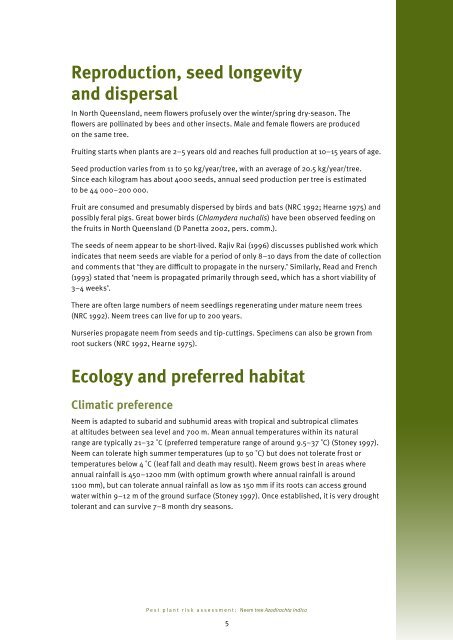Pest plant risk assessment:Neem treeâAzadirachta indica
Pest plant risk assessment:Neem treeâAzadirachta indica
Pest plant risk assessment:Neem treeâAzadirachta indica
You also want an ePaper? Increase the reach of your titles
YUMPU automatically turns print PDFs into web optimized ePapers that Google loves.
Reproduction, seed longevity<br />
and dispersal<br />
In North Queensland, neem flowers profusely over the winter/spring dry-season. The<br />
flowers are pollinated by bees and other insects. Male and female flowers are produced<br />
on the same tree.<br />
Fruiting starts when <strong>plant</strong>s are 2–5 years old and reaches full production at 10–15 years of age.<br />
Seed production varies from 11 to 50 kg/year/tree, with an average of 20.5 kg/year/tree.<br />
Since each kilogram has about 4000 seeds, annual seed production per tree is estimated<br />
to be 44 000–200 000.<br />
Fruit are consumed and presumably dispersed by birds and bats (NRC 1992; Hearne 1975) and<br />
possibly feral pigs. Great bower birds (Chlamydera nuchalis) have been observed feeding on<br />
the fruits in North Queensland (D Panetta 2002, pers. comm.).<br />
The seeds of neem appear to be short-lived. Rajiv Rai (1996) discusses published work which<br />
<strong>indica</strong>tes that neem seeds are viable for a period of only 8–10 days from the date of collection<br />
and comments that ‘they are difficult to propagate in the nursery.’ Similarly, Read and French<br />
(1993) stated that ‘neem is propagated primarily through seed, which has a short viability of<br />
3–4 weeks’.<br />
There are often large numbers of neem seedlings regenerating under mature neem trees<br />
(NRC 1992). <strong>Neem</strong> trees can live for up to 200 years.<br />
Nurseries propagate neem from seeds and tip-cuttings. Specimens can also be grown from<br />
root suckers (NRC 1992, Hearne 1975).<br />
Ecology and preferred habitat<br />
Climatic preference<br />
<strong>Neem</strong> is adapted to subarid and subhumid areas with tropical and subtropical climates<br />
at altitudes between sea level and 700 m. Mean annual temperatures within its natural<br />
range are typically 21–32 ˚C (preferred temperature range of around 9.5–37 ˚C) (Stoney 1997).<br />
<strong>Neem</strong> can tolerate high summer temperatures (up to 50 ˚C) but does not tolerate frost or<br />
temperatures below 4 ˚C (leaf fall and death may result). <strong>Neem</strong> grows best in areas where<br />
annual rainfall is 450–1200 mm (with optimum growth where annual rainfall is around<br />
1100 mm), but can tolerate annual rainfall as low as 150 mm if its roots can access ground<br />
water within 9–12 m of the ground surface (Stoney 1997). Once established, it is very drought<br />
tolerant and can survive 7–8 month dry seasons.<br />
P e s t p l a n t r i s k a s s e s s m e n t : <strong>Neem</strong> tree Azadirachta <strong>indica</strong><br />
5
















